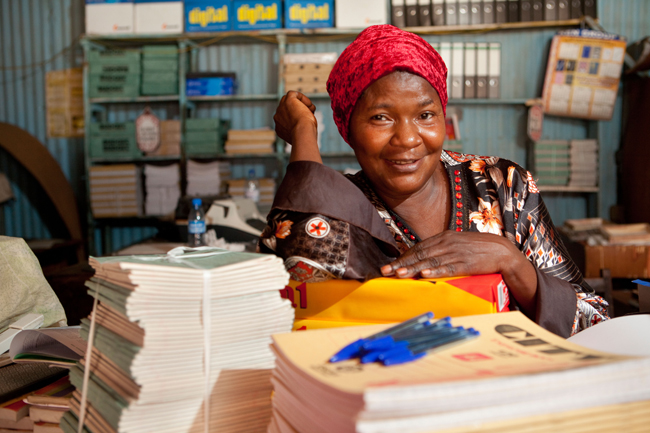Please note: This blog post is authored by Laura S.L. Herman, Managing Director, FSG, Alexandra Geertz, Director, FSG, and Talia Alongi, Consultant, FSG.
In recent years, companies have increasingly focused their CSR efforts on creating opportunities for women and girls. CSR gender efforts often start with a focus on bringing women “up to speed” through trainings, hiring quotas, and scholarships. For example, in the financial services sector, a significant number of companies have some portion of their CSR portfolio dedicated to financial literacy for women around the world. These investments focus on issues ranging from household finances to entrepreneurial business skills to salary negotiations.
This type of education and capacity building is important. But if a woman cannot take out a loan without her husband’s approval, managing household finances remains out of reach. If social norms dictate that a woman cannot work outside the home or travel alone to other communities, she cannot use the business skills she’s developed to engage in the workforce. There is a limit to how effective individual-level interventions can be.

Going Beyond the Individual
We see leading companies and their partners going beyond programs that target individual women or girls and considering the relationships and systemic factors that influence women’s ability to thrive and succeed. CSR programs that strive to create gender equity must be thoughtfully and intentionally developed to consider complex social, economic, cultural, and political nuances, such as household decision-making dynamics, gender roles, and access to resources. The examples below illustrate the types of considerations, research, and collaboration necessary for holistic and long-lasting solutions.
The apparel industry drives innovation in gender-focused programs
Nearly 75 percent of workers in the apparel sector are women, making gender-related workplace issues incredibly relevant for companies in the industry. The evolution of individual companies and industry coalitions in this sector offer insights into the processes and program design necessary to do this work successfully.
Gap Inc.’s P.A.C.E. (Personal Advancement and Career Enhancement) program provides life skills and technical training to female garment workers through a set of 9 standardized modules that address reproductive health, literacy, and professional skills. One of the modules is specifically focused on gender roles and aims to help women better understand the roles and norms that influence their opportunities and access to resources. Women who have participated in the program share stories of how they’ve used this training to influence their domestic workload and create a more equitable balance at home. One participant brought the lessons from the gender roles module home and shared them with her husband, and now they share the domestic workload because he no longer sees it as women’s work.
Others in the apparel sector have expanded their efforts to the next level, beyond both the individual and their immediate context to address the systems and policies that shape women’s opportunities. The Business Coalition for Women (BCFW) is an IFC-sponsored membership organization of 50 businesses in Papua New Guinea. They identified an issue with gender-based violence in their workforce and together developed a suite of practical tools, policy advice, training resources, and referral information for employers and female employees, and publicly advocated for the issue.
Tata Tea advocates for school-based gender education in India
In India, Tata Tea is also taking an approach that addresses both contextual and policy influences on gender equity. The company is utilizing marketing and advocacy to promote national policy shifts in education requirements. Their “Jaago Re” advocacy platform recently established a petition to urge the Indian government to make gender sensitization classes mandatory in schools. These classes have been piloted in Mumbai and the state of Jharkhand and a recent evaluation showed that the program leads to increased engagement across genders, increased communication, and decreased acceptance and perpetration of violence. Importantly, Tata Tea has also included a direct effort to engage men in gender equity efforts and a policy level effort to enact national change.
As companies expand their understanding of gender equity and what it takes to achieve it, they embrace these broader contextual and systemic opportunities to ensure the success and sustainability of investments that might initially seek to empower women and girls as individuals.
Approaches to Designing Greater Impact
How can companies take steps to improve the effectiveness of their approach to social impact and gender equity?
Incorporate the voice of women and girls: Bring in the voices of women and girls to ground the program in real-life experiences. This is often more challenging than it seems, as social norms can prevent women from participating in research or advocating for their perspectives. The resulting survey data or qualitative reports won’t capture women’s needs or life experiences, as men are reporting on women’s behalf.
Alternatively, women-centered design ensures that the views of the target audience directly influences program design. Project Laser Beam is a collaboration between the UN World Food Program and corporate partners to tackle child undernutrition. The project design took a holistic approach and tapped the expertise of female leaders in the community to create locally and contextually relevant solutions.
Conduct gender analyses: Context-specific gender analyses can surface barriers that are fundamental to addressing gender equity. Both qualitative and quantitative data can be used to understand when and how gender plays a role and when other factors such as class, race, or economic status may be more dominant factors. Kellogg used a gender analysis to inform the design of their program to empower women smallholder farmers in the Indian State of Odisha, in partnership with CARE. In addition to providing training on sustainable agricultural practices, the program worked to increase their incomes and savings, as well as their social standing and equitable engagement with men in households and the larger community. Women’s collectives and self-help groups aimed to build solidarity and strength amongst the participants of the program. As a result, almost 500 women have gained access to agricultural inputs and markets, 3 women leaders are embedded into the project villages to drive women’s inclusion and equality, and men in the community are supporting and promoting women smallholder farmers.
Invest in baseline research: Before any CSR program begins, it is good practice to start with baseline data collection that is sex-disaggregated to ensure that the program starts with an aligned understanding of the problem. This baseline can be used to measure progress as the program advances and capture outcomes across men and women separately. We’ve seen some companies conduct this research themselves, while others partner with external experts. Data2X is a collaborative technical and advocacy platform that partners with both private and public sectors to expand gender disaggregated data in order to improve outcomes for women and girls.
Map the ecosystem: Project design should include a holistic understanding of all of the private and public players in the issue and target geography. This will allow greater visibility into the broader set of resources that corporate investments plug into and the distinct role they play. Ecosystem mapping also ensures that while a company may not work at the individual, relational, and systems level, it can be sure that its intervention is not happening in isolation or duplicating existing efforts, giving it a higher probability of success.
Coca-Cola’s “golden triangle” partnership approach outlines the importance of businesses, governments, and civil society organizations working together. Their approach is based on robust visibility into the full set of actors, and clearly positions their own expertise (supply chain, marketing, and distribution) within that system. It also quickly highlights partnership opportunities.
Our research suggests that CSR can play an important role in advancing gender equity when it is designed for the complexities of real life. Acknowledging the web of challenges within families, communities, and at the policy level that shape a woman’s experience is critical to implementing effective CSR programming. These power dynamics are complex and challenging to navigate, but by improving gender equity we improve outcomes for all. We look forward to hearing from you about what you would add to the list above. What else should companies be doing to ensure the long-term success of women and girls and the communities they influence?


